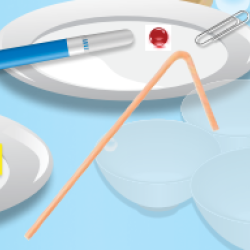Source Institutions
Source Institutions
Add to list Go to activity
Activity link broken? See if it's at the internet archive

In this activity on page 12 of the PDF (Rethinking the 3 R’s: It’s Easy to be Green), learners examine how recyclable materials are separated by various properties at recycling centers. Learners determine the density of various objects as well as if the materials are magnetic. Use this activity to discuss the properties of matter and the importance of recycling.
Safety notes: Follow Milli's safety tips on page 13 and do this activity with an adult.
Safety notes: Follow Milli's safety tips on page 13 and do this activity with an adult.
- Under 5 minutes
- 45 to 60 minutes
- $5 - $10 per student
- Ages 8 - 14
- Activity, Experiment/Lab Activity
- English
Quick Guide
Materials List (per student)
- Polyethylene Terephthalate (Resin ID code 1) — such as plastic water bottles, soda bottles
- High-Density Polyethylene (Resin ID code 2) — such as milk jugs, detergent bottles
- Low-Density Polyethylene (Resin ID code 4) — such as six-pack rings
- Polypropylene (Resin ID code 5) — such as bottle caps, drinking straws, yogurt containers
- Polystyrene (Resin ID code 6) — such as disposable coffee cups
- Measuring spoons
- One marble
- One paper clip
- Water
- Sodium chloride (table salt)
- Magnet
- Isopropyl rubbing alcohol 70%
- Light corn syrup
- 3 small clear bowls or containers
- Two plates
- Tongs
- Tape
- Marker
Subjects
-
Engineering and Technology
-
Engineering
- Chemical Engineering
-
Engineering
-
Physical Sciences
-
Electricity and Magnetism
- Electromagnetic Fields
- Chemistry
-
Motion and Forces
- Gravity
-
States of Matter
- Solids
-
Structure and Properties of Matter
- Atomic Structure
- Volume and Density
-
Electricity and Magnetism
-
The Nature of Science
-
The Scientific Process
- Conducting Investigations
- Gathering Data
- Formulating Explanations
- Communicating Results
-
The Scientific Process
-
The Nature of Technology
-
Technology and Society
- Technology and the Environment
-
Technology and Society
Informal Categories
- Nature and Environment
Audience
To use this activity, learners need to:
- see
- read
- touch
Learning styles supported:
- Uses STEM to solve real-world problems
- Involves hands-on or lab activities
Other
Foreign language versions of this resource:
Access Rights:
- Free access
By:
- Golden, Melissa ; Harnden, Gregory ; Dougherty, Ryan
Rights:
- All rights reserved, American Chemical Society, 2012
